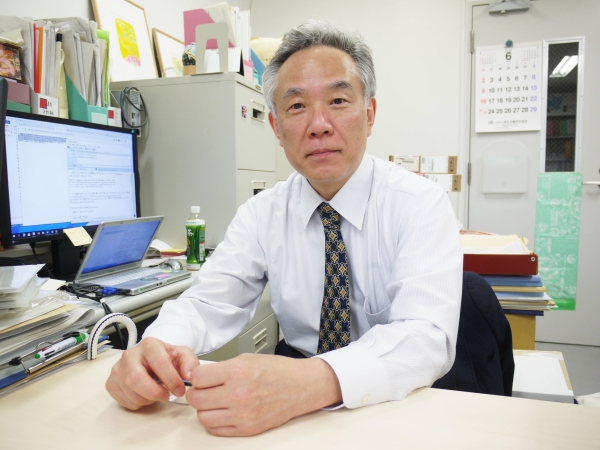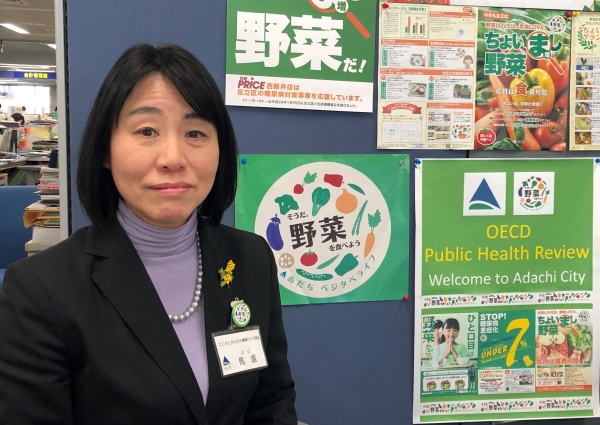Healthy living made appetizing UTokyo researcher helps Tokyo community boost vegetable intake


Credit: Shutterstock
“Eat your vegetables!”
We’ve all heard this gospel of health and we all know the benefits of a balanced diet filled with fruits and vegetables. But for many, it’s hard to keep up the habit day after day.
In Tokyo’s Adachi ward, however, a unique communitywide campaign involving a University of Tokyo researcher has succeeded in boosting the intake of vegetables among residents. Adachi is becoming recognized, not only in Japan but even internationally, as a city that allows residents to become healthy just by living there.
Hideki Hashimoto, professor at UTokyo’s School of Public Health, got involved in the ward’s campaign through an interdisciplinary research project that looked into the mechanism of social stratification and economic disparity. That project, started in 2009, was headed by Norito Kawakami, also professor at the School of Public Health.
“Health disparity was a research field that had been largely neglected for a long time,” Hashimoto said. “We tried to look at the issue from the viewpoint of various academic fields, including economics, sociology and other disciplines. Our goal was to find ways to eliminate health inequality, if not socioeconomic inequality, among people.”

Professor Hideki Hashimoto at the University of Tokyo School of Public Health
For that study, Hashimoto, who was tasked with surveying communities, sent questionnaires to residents in four municipalities with different characteristics, such as a bedroom community with an aging population, another bedroom town with relatively high-income earners, and Adachi, which is known for its shitamachi lowland neighborhoods dotted by small shops and factories.
Having enlisted the help of each municipal government, Hashimoto’s team surveyed the socioeconomic conditions of individuals and their family members “down to the smallest details,” including their income levels, academic backgrounds, lifestyle habits, health conditions and how they utilized medical services. The survey, conducted in 2010, 2011 and 2013, covered over 4,000 people.
The results showed that in every community surveyed, respondents with college degrees were found to be more health-conscious than those without.
“People’s educational backgrounds had correlations with their own, and their family’s, intake of vegetables. For fruits, which can be expensive, the amount of consumption had more to do with the respondents’ income. But the amounts of brightly colored vegetables consumed were markedly different between households where mothers had a college degree and ones where they didn’t.”
Currently, the Ministry of Health, Labor and Welfare recommends a daily vegetable intake of 350 grams per person. The amount of vegetables consumed daily varied by as much as 20 grams between families with college-educated mothers and those with high school-educated moms, the survey found.
Hashimoto explains that further studies on the relationship between academic achievements and the amount of vegetable consumption are needed, to find out whether the discrepancies reflect differences in people’s awareness and knowledge, or whether the lack of skills or time plays a role.
Hashimoto explained the survey results to officials of the four municipalities, with hopes they would utilize the data to improve community health. Among the municipalities, Adachi paid heed and took action.
Healthy life span
At the forefront of Adachi’s health promotion campaign is Yuko Baba, head of the mental and physical health promotion section at the municipal government. Baba, who is a public health nurse, has also worked on suicide prevention policies.

Yuko Baba, head of the mental and physical health promotion section at the Adachi ward office
Adachi, the fifth most populous of Tokyo’s 23 wards, is home to 680,000 people, but its population has rapidly grayed in recent years. The percentage of people on welfare is the second highest in the 23 wards, at 3.68 percent, while the healthy life expectancy — the number of years a person is expected to be in good health — of its residents stands at 76.36 years for men and 81.04 years for women, about two years shorter than the average span in Tokyo and across Japan.
“We tried hard to nail down why our healthy life expectancy was so low, compared with the national and Tokyo levels,” Baba said. “As we kept investigating, we found that the biggest outlay the ward made under the national health insurance scheme was on kidney diseases, including dialysis. The health spending for high blood pressure was second highest, followed by diabetes ranking third. Since about half of all dialysis cases were linked to diabetes, diabetes was in fact the largest contributor to the ward’s medical expenditures. Also, diabetes can lead to various other diseases, such as strokes, heart attacks and the hardening of arteries. It became clear that diabetes is the most pressing health issue the ward faces.”
Until then, the municipal government’s health promotion measures consisted mainly of general awareness-raising seminars for its residents, such as public lectures on hypertension and diabetes, Baba said, noting that such events had limited impact because they attracted only a small segment of the population.
Based on Hashimoto’s data, the officials decided to try a different tack. They decided to focus on diabetes prevention, and specifically on trying to improve the diet of residents.
Baba first consulted Hashimoto on her plan to increase vegetable consumption among the ward’s residents in 2013. Since then, the UTokyo professor has supported her by offering expert advice and conducting follow-up research.

A local supermarket participates in the Vege-tabe Life campaign. Photo courtesy of the Adachi ward office.
The first thing Baba and other officials did was to visit restaurants and bars around local stations, asking the eatery owners to add vegetable-rich dishes to their menus. At izakaya bars, for example, Baba asked them to serve vegetable sticks as an appetizer, while at ramen noodle stores she asked that vegetable toppings be added as options.
Dubbing the campaign “Vege-tabe Life,” with “vege” meaning vegetables and “tabe” coming from the Japanese verb taberu (to eat), Baba told the establishments that, though the ward cannot offer cash incentives, it can promote them as Vege-tabe Life supporters on the municipal government’s website if they participate.
It worked. Now over 700 eateries, or 12 percent of all restaurants and bars in Adachi, are listed as supporters of Vege-tabe Life, by serving mini salads or dishes that contain at least 120 grams of vegetables each.
In addition, Baba worked with the ward’s certified nutritionists to come up with supersimple veggie recipes, which she distributed as recipe cards. She also made numerous visits to a merchant who played a key role in the local farm produce market, to make it easier for residents, including singles, to buy vegetables — such as by packaging produce in smaller portions, offering cut vegetables and providing recipes to customers.
Hashimoto became convinced of the campaign’s success in increasing the vegetable intake among residents, and conducted follow-up research. The survey, conducted in 2015 and 2016, found that, despite their soaring costs at the time, household consumption of vegetables in Adachi rose compared to the 2013-2014 levels. This was true not only in families with college-educated moms, but also in families where mothers had a high-school education or below, Hashimoto said.
Adachi didn’t stop there. The ward has been stepping up efforts to foster healthy dietary habits among schoolchildren by teaching basic cooking skills at junior high schools across the district. Now every student in Adachi learns in school how to cook rice, make miso soup without relying on instant packs and prepare a simple dish like fried eggs.
In November 2017, the Adachi Vege-tabe Life campaign won the Japanese health ministry’s health bureau director general award, given to efforts to prevent lifestyle diseases. And in February 2019, the Organization for Economic Cooperation and Development mentioned Adachi’s initiative in its report that reviewed Japan’s health policy, calling it “close to international best practice.”
Intervening through children
Baba says she is thankful for Hashimoto’s support.
“Professor Hashimoto doesn’t put academic interests first,” she said. “He provides all data to us, saying we can use them as we wish. He also teaches us how to interpret the data, preparing detailed documents that explain in plain terms what they mean. Other researchers who approached us before just shared a small portion of their research afterward, as a token gesture.

Elementary school children practice how to stir-fry komatsuna (Japanese mustard spinach) and nori seaweed during a cooking lesson at school. Photo courtesy of the Adachi ward office.
“The average education levels of residents in our ward are slightly lower than those in other municipalities. Data provided by Professor Hashimoto helped us understand how such a situation affects our residents’ health and made us think how to go about tackling the challenge. That led us to come up with the idea of intervening through children. We now find that approach to be working.”
Hashimoto said he wants to continue assisting the ward through research.
“If children change, adults change,” Hashimoto said. “The family diet changes if children come home and say, ‘Hey, I learned how to cook at school. Cook the same dish at home, too.’ Local governments have struggled to reach out to people in their 30s and 40s, who are often too busy to show up for public health screenings. The officials can reach out to all children because they are in school, and they could become a catalyst for change in the community. I would like to track how the children we surveyed this time will fare over the long term.”
Interview/Text: Tomoko Otake






